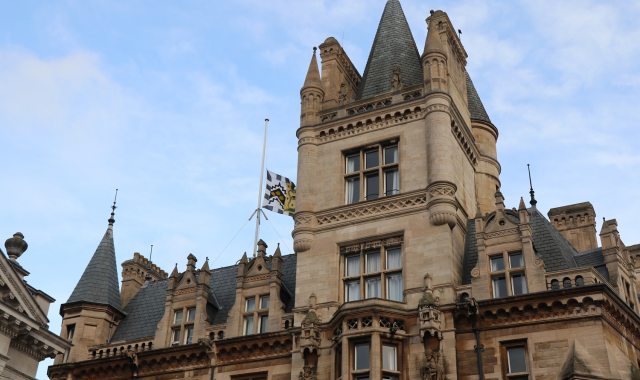New Caius punt officially launched
- 16 May 2017
- 4 minutes
A new Caius punt, the narrow wooden boat traditionally seen being poled along the serene river Cam, has been launched by the Master of the College, Professor Sir Alan Fersht.
The craft, built locally using long-established techniques, is named the Lady Marilyn, after Marilyn, Lady Fersht, wife of the Master.
Delivered earlier this month, the punt was officially launched this week with a bottle of College champagne at a ceremony at St John’s punt pool (where the boat is moored).
Funded thanks to the Development Office through generous gifts to the College, the punt is available all spring and summer for the use of College students, Fellows, staff, alumni and benefactors.
The new craft was commissioned from boatbuilder Steve Lowings, who also built the previous Caius punt, Bella. Steve, who works from Jones Boatyard, is soon to retire after 48 years running his one-man business. Lady Marilyn one of the last punts he will build before hanging up his tools at the end of this month (there are just two more to finish).
At the launch, Caius Keeper of Punts Dr Jimmy Altham said: “We don’t very often have a splendid opportunity to express our gratitude to the spouse of the Master of a College.
“Marilyn has been a tower of exemplary support for the Master and has been really overall a great member of the College.”
After the naming, Lady Fersht and the Master tried out the new craft, accompanied by Gonville & Caius Student Union President Nathalie Holloway and MCR President Hugo Larose, with Caius Boatman Simon Goodbrand expertly guiding the punt under the Bridge of Sighs.
Punts, with their small draft and lack of keel, are well-suited to the flat, shallow waters of the Fens around Cambridge and were traditionally used for trades such as eel fishing, reed-cutting and fowling before becoming pleasure craft on the Cam over a century ago. Often far longer than today, they could also carry cattle across rivers to fresh pasture.
The Caius craft is 6.4 metres long and a metre wide, with room for six including the pilot, who propels the boat with a long pole. Punters in Cambridge stand on the flat deck at the stern of the boat, dragging the pole in the water as a rudder, while those in Oxford stand within the boat at the bow.
While the dimensions of the College punt are standard, its design – with sides gently curving in to meet the flat ends of the boat – is unique to Steve Lowings. “Some punts on the river are like wardrobes – they’re just a square box,” he said. “Mine have got a shape, and hopefully they’re the best looking boats on the river.” The design is not simply a matter of aesthetics, he adds. “I’ve had comments from people saying they prefer the shape of my punts because they cut through the water better.”
Every Lowings punt is made from one-inch Senegalese mahogany, with the sides made from a single plank of wood. The bottom of the boat is made from 12mm Lloyd registered marine plywood, and runners and duck boards are made of pine. Metal banding is fitted to the bottom runners and both ends, and finally the punt is preserved and finished in marine varnish and painted – the whole process taking around three weeks.
“The boats have traditionally been made of mahogany – it’s resilient and there is not much movement, but at the same time it will bend to form the sides and has a nice-looking colour,” Steve said. Punts need to be resilient: the average pilot struggles to negotiate the narrow Cam and the unpredictability of others on the water, and bumps are common. In the old days, with more skilled use, the boats could last over a century, but now their river shelf life is far shorter, Steve reports. “I used to refurbish one that was over 120 years old, and now, if they’re looked after, they will still last probably 40 years.”
Dr Altham, a Caius Philosophy Fellow who doubles as Keeper of Punts, is a great enthusiast for the craft. "Punting is slow and quiet, and provides respite from anxious and hurried lives. The oars of a rowing boat take up too much room on the most congested stretches of the Cam, and a punter faces forward, whereas rowers, if without a cox, have to keep craning their necks round to watch out for other craft.
"Punts are sociable, and invite consumption of strawberries on summer days. They can be moored en masse by the bank to form an audience for a concert, and hardy revellers, at the end of a May Ball, punt up to Grantchester for breakfast, in vain hope that the party will never end. A pupil of mine, after her marriage in Caius Chapel, was taken, still in her wedding dress and in a punt full of flowers, along the river to her reception in Queens’, a scene of unforgettable beauty and romance."


